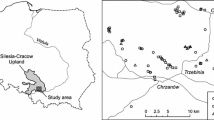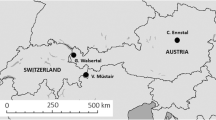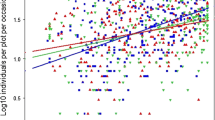Abstract
Increasing evidence suggests that past human activities have irreversibly changed soil properties and biodiversity patterns. In the White Carpathian Mts (Central-Eastern Europe), a mosaic of hyper-species-rich and species-rich patches have developed in a regularly mown dry grassland in the area of a glassworks abandoned in the eighteenth century. We tested whether and how anthropogenically changed soils affected the distribution of extraordinary species richness. Using magnetometry we detected former furnaces, workspace, waste deposit and unaffected surrounding grasslands and compared their vegetation and environmental conditions. Archaeological features, especially furnaces and waste deposits, showed a higher pH, higher soil concentrations of exchangeable phosphorus, manganese, lead and calcium, and higher productivity. Surrounding grassland showed higher iron and sodium concentrations in the soil, higher N:P ratio in the biomass and higher species richness. Moisture was uniformly lower in soils on archaeological features, where non-trivially a more ‘mesic’ vegetation in terms of European habitat classification occurred. Plant compositional variation was best explained by water-extractable phosphorus. Because nutrient-richer patches were not moister as common elsewhere, and because species richness was only poorly accounted for by productivity, the occurrence of a species-poor ‘mesic’ vegetation on archaeological features was evidently caused by a long-lasting phosphorus oversupply which favours a comparatively small species pool of rather recently arriving species. On the contrary, surrounding phosphorus-poorer grasslands still contain the ancient species pool whose extraordinary size determines the exceptional species richness of grasslands in the study region. Its maintenance or restoration demands a persistent phosphorus deficiency.





Similar content being viewed by others
References
Araya YN, Gowing DJ, Dise N. 2013. Does soil nitrogen availability mediate the response of grassland composition to water regime? J Veg Sci 24:506–17.
Beven KJ, Kirkby MJ. 1979. A physically based, variable contributing area model of basin hydrology. Hydrol Sci Bull 24:43–69.
Biek L, Bayley J. 1979. Glass and other vitreous materials. World Archaeol 11:1–25.
Boecker D, Centeri C, Welp G, Möseler BM. 2015. Parallels of secondary grassland succession and soil regeneration in a chronosequence of central-Hungarian old fields. Folia Geobotanica 50:91–106.
Cachovanová L, Hájek M, Fajmonová Z, Marrs R. 2012. Species richness, community specialization and soil-vegetation relationships of managed grasslands in a geologically heterogeneous landscape. Folia Geobotanica 47:349–71.
Ceulemans T, Merckx R, Hens M, Honnay O. 2013. Plant species loss from European semi-natural grasslands following nutrient enrichment. Is it nitrogen or is it phosphorus? Glob Ecol Biogeogr 22:73–82.
Ceulemans T, Stevens CJ, Duchateau L, Jacquemyn H, Gowng DJG, Merckx R, Wallace H, van Rooijen N, Goethem T, Bobbink R, Dorland E, Gaudnik C, Alard D, Corcket E, Muller S, Dise NB, Dupr C, Diekmann M, Honnay O. 2014. Soil phosphorus constrains biodiversity across European grasslands. Glob Change Biol 20:3814–22.
Chytrý M, Ed. 2007. Vegetace České republiky 1. Travinná a keříčková vegetace [Vegetation of the Czech Republic 1. Grassland and heathland vegetation]. Praha: Academia Praha.
Chytrý M, Dražil T, Hájek M, Kalníková V, Preislerová Z, Šibík J, Ujházy K, Axmanová I, Bernátová D, Blanár D, Dančák M, Dřevojan P, Fajmon K, Galvánek D, Hájková P, Herben T, Hrivnák R, Janeček Š, Janišová M, Jiráská Š, Kliment J, Kochjarová J, Lepš J, Leskovjanská A, Merunková K, Mládek J, Slezák M, Šeffer J, Šefferová V, Škodová I, Uhlířová J, Ujházyová M, Vymazalová M. 2015. The most species-rich plant communities in the Czech Republic and Slovakia (with new world records). Preslia 87:217–78.
Chytrý M, Rafajová M. 2003. Czech National Phytosociological Database: basic statistics of the available vegetation-plot data. Preslia 75:1–15.
Cílová Z, Woitsch J. 2012. Potash–a key raw material of glass batch for Bohemian glasses from 14th–17th centuries? J Archaeol Sci 39:371–80.
Closset-Kopp D, Decocq G. 2015. Remnant artificial habitats as biodiversity islets into forest oceans. Ecosystems 18:507–19.
de Mazancourt C, Isbell F, Larocque A, Berendse F, Luca E, Grace JB, Haegeman B, Polley HW, Roscher C, Schmid B, Tilman D, van Ruijven J, Weigelt A, Wilsey BJ, Loreau M. 2013. Predicting ecosystem stability from community composition and biodiversity. Ecol Lett 16:617–25.
Dengler J, Janišová M, Török P, Wellstein C. 2014. Biodiversity of Palaearctic grasslands: a synthesis. Agric Ecosyst Environ 182:1–14.
Duffková R, Hejcman M, Libichová H. 2015. Effect of cattle slurry on soil and herbage chemical properties, yield, nutrient balance and plant species composition of moderately dry Arrhenatherion grassland. Agric Ecosyst Environ 213:281–9.
Dupouey JL, Dambrine E, Laffite JD, Moares C. 2002. Irreversible impact of past land use on forest soils and biodiversity. Ecology 83:2978–84.
Ewald J. 2003. The calcareous riddle: why are there so many calciphilous species in the Central European flora? Folia Geobotanica 38:357–66.
Grace JB, Anderson TM, Seabloom EW, Borer ET, Adler PB, Harpole WS, Hautier Y, Hillebrand H, Lind EM, Pärtel M, Bakker JD, Buckley YM, Crawley MJ, Damschen EI, Davies KF, Fay PA, Firn J, Gruner DS, Hector A, Knops JM, MacDougall AS, Melbourne BA, Morgan JW, Orrock JL, Prober SM, Smith MD. 2016. Integrative modelling reveals mechanisms linking productivity and plant species richness. Nature 529:390–3.
Güsewell S, Bailey KM, Roem WJ, Bedford BL. 2005. Nutrient limitation and botanical diversity in wetlands: can fertilisation raise species richness? Oikos 109:71–80.
Gustafsson BG, Schenk F, Blenckner T, Eilola K, Meier HEM, Müller-Karulis B, Neumann T, Ruoho-Airola T, Savchuk OP, Zorita E. 2012. Reconstructing the development of Baltic Sea eutrophication 1850–2006. Ambio 41:534–48.
Hájek M, Dudová L, Hájková P, Roleček J, Moutelíková J, Jamrichová E, Horsák M. 2016. Contrasting Holocene environmental histories may explain patterns of species richness and rarity in a Central European landscape. Quatern Sci Rev 133:48–61.
Hautier Y, Seabloom EW, Borer ET, Adler PB, Harpole WS, Hillebrand H, Lind EM, MacDougall AS, Stevens CJ, Bakker JD, Buckley YM, Chu Ch, Collins SL, Daleo P, Damschen EI, Davies KF, Fay PA, Firn J, Gruner DS, Jin VL, Klein JA, Knops JMH, La Pierre KJ, Li W, McCulley RL. 2014. Eutrophication weakens stabilizing effects of diversity in natural grasslands. Nature 508:521–5.
Hejcman M, Klaudisová M, Štursa J, Pavlů V, Schellberg J, Hejcmanová P, Hakla J, Rauch O, Vacek S. 2007. Revisiting a 37 years abandoned fertilizer experiment on Nardus grassland in the Czech Republic. Agric Ecosyst Environ 118:231–6.
Hejcman M, Szaková J, Schellberg J, Šrek P, Tlustoš P. 2009. The Rengen Grassland Experiment: soil contamination by trace elements after 65 years of Ca, N, P and K fertiliser application. Nutr Cycl Agroecosyst 83:39–50.
Hejcman M, Karlík P, Ondráček J, Klír T. 2013a. Short-term medieval settlement activities irreversibly changed forest soils and vegetation in Central Europe. Ecosystems 16:652–63.
Hejcman M, Hejcmanová P, Pavlů V, Beneš J. 2013b. Origin and history of grasslands in Central Europe—a review. Grass Forage Sci 68:345–63.
Helsen K, Ceulemans T, Stevens CJ, Honnay O. 2014. Increasing soil nutrient loads of European semi-natural grasslands strongly alter plant functional diversity independently of species loss. Ecosystems 17:169–81.
Hunt CO, Gilbertson DD, El-Rishi HA. 2007. An 8000-year history of landscape, climate, and copper exploitation in the Middle East: the Wadi Faynan and the Wadi Dana National Reserve in southern Jordan. J Archaeol Sci 34:1306–38.
Isbell F, Tilamn D, Polasky S, Binder S, Hawthorne P. 2013. Low biodiversity state persists two decades after cessation of nutrient enrichment. Ecol Lett 16:454–60.
Jongepierová I, Ed. 2008. Louky Bílých Karpat [Grasslands of the White Carpathian Mountains]. Veselí nad Moravou: ZO ČSOP Bílé Karpaty.
Jonasson S. 1992. Plant responses to fertilization and species removal in tundra related to community structure and clonality. Oikos 63:420–9.
Kapusta P, Szarek-Łukaszewska G, Jędrzejczyk-Korycińska M, Zagórna M. 2015. Do heavy-metal grassland species survive under a Scots pine canopy during early stages of secondary succession? Folia Geobotanica 50:317–29.
Karlík P, Poschlod P. 2014. Půdní semenná banka a nadzemní vegetace suchého trávníku „V nákli“ u Srbska v Českém krasu. Bohemia Cent 32:277–96.
Klimeš L, Hájek M, Mudrák O, Dančák M, Preislerová Z, Hájková P, Jongepierová I, Klimešová J. 2013. Effects of changes in management on resistance and resilience in three grassland communities. Appl Veg Sci 16:640–9.
Kuneš P, Odgaard BV, Gaillard M-J. 2011. Soil phosphorus as a control of productivity and openness in temperate interglacial forest ecosystems. J Biogeogr 38:2150–64.
Kuneš P, Svobodová-Svitavská H, Kolář J, Hajnalová M, Abraham V, Macek M, Tkáč P, Szabó P. 2015. The origin of grasslands in the temperate forest zone of east-central Europe: long-term legacy of climate and human impact. Quatern Sci Rev 116:15–27.
Laliberté R, Zemunik G, Turner BL. 2014. Environmental filtering explains variation in plant diversity along resource gradients. Science 345:1602–5.
Lambers H, Plaxton WC. 2015. Phosphorus: back to the roots. Annual Plant Rev 48:3–22.
Marini L, Scotton M, Klimek S, Isselstein J, Pecile A. 2007. Effects of local factors on plant species richness and composition of Alpine meadows. Agric Ecosyst Environ 119:281–8.
Marlon JR, Bartlein PJ, Daniau A-L, Harrison SP, Maezumi SY, Power MJ, Tinner W, Vanniér B. 2013. Global biomass burning: a synthesis and review of Holocene paleofire records and their controls. Quatern Sci Rev 65:5–25.
Martinuzzi S, Gavier-Pizarro GI, Lugo AE, Radeloff VC. 2015. Future land-use changes and the potential for novelty in ecosystems of the United States. Ecosystems 18:1332–42.
McGill BJ, Dornelas M, Gotelli NJ, Magurran AE. 2015. Fifteen forms of biodiversity trend in the Anthropocene. Trends Ecol Evol 30:104–13.
Merunková K, Chytrý M. 2012. Environmental control of species richness and composition in upland grasslands of the southern Czech Republic. Plant Ecol 213:591–602.
Mládková P, Mládek J, Hejduk S, Hejcman M, Cruz P, Jouany C, Pakeman RJ. 2015. High-nature-value grasslands have the capacity to cope with nutrient impoverishment induced by mowing and livestock grazing. J Appl Ecol 52:1073–81.
Monge G, Jimenez-Espejo FJ, García-Alix A, Martínez-Ruiz F, Mattielli N, Finlayson C, Ohkouchi N, Sánchez MC, de Castro JMB, Blasco R, Rosell J, Carrión J, Rodríguez-Vidal J, Finlayson G. 2015. Earliest evidence of pollution by heavy metals in archaeological sites. Sci Rep 5:14252.
Newbound M, McCarthy MA, Lebel T. 2010. Fungi and the urban environment: a review. Landsc Urban Plann 96:138–45.
Olde Venterink H. 2011. Does phosphorus limitation promote species-rich plant communities? Plant Soil 345:1–9.
Oliver MA. 1990. Kriging: a method of interpolation for geographical information systems. Int J Geograph Inf Syst 4:313–32.
Palmer MW. 1994. Variation in species richness: towards a unification of hypotheses. Folia Geobotanica et Phytotaxonomica 29:511–30.
Peñuelas J, Sardans J, Rivas-Ubach A, Janssens IA. 2012. The human-induced imbalance between C, N and P in Earth’s life system. Glob Change Biol 18:3–6.
Poschlod P, Baumann A, Karlík P. 2009. Origin and development of grasslands in central Europe. In: Veen P, Jefferson R, De Smidt J, Van der Straaten J, Eds. Grasslands in Europe of high nature value. Zeist: KNNV Publishing. pp 15–25.
Prach K, Jongepierová I, Řehounková K, Fajmon K. 2014. Restoration of grasslands on ex-arable land using regional and commercial seed mixtures and spontaneous succession: successional trajectories and changes in species richness. Agric Ecosyst Environ 182:131–6.
Prach K, Fajmon K, Jongepierová I, Řehounková K. 2015. Landscape context in colonization of restored dry grasslands by target species. Appl Veg Sci 26:181–9.
Provan DM. 1973. The soils of an iron age farm site—Bjellandsoynae, SW Norway. Nor Archaeol Rev 6:30–41.
Pyšek P, Danihelka J, Sádlo J, Chrtek J Jr, Chytrý M, Jarošík V, Kaplan Z, Krahulec F, Moravcová L, Pergl J, Štajerová K, Tichý L. 2012. Catalogue of alien plants of the Czech Republic: checklist update, taxonomic diversity and invasion patterns. Preslia 84:155–255.
Radeloff VC, Williams JW, Bateman BL, Burke KD, Carter SK, Childress ES, Cromwell KJ, Gratton C, Hasley AO, Kraemer BM, Latzka AW, Marin-Spiotta E, Meine CD, Munoz SE, Neeson TM, Pidgeon AM. 2015. The rise of novelty in ecosystems. Ecol Appl 25:2051–68.
Roleček J, Čornej II, Tokarjuk AI. 2014. Understanding the extreme species richness of semi-dry grasslands in east-central Europe: a comparative approach. Preslia 86:13–34.
Roleček J, Hájek M, Karlík P, Novák J. 2015. Reliktní vegetace na mezických stanovištích. [Relict vegetation on mesic sites]. Zprávy České Botanické Společnosti 50:201–45.
Romey C, Vella C, Rochette P, Andrieu-Ponel V, M-agnin F, Veron A, Talon B, Landuré C, D’Ovidio AM, Delanghe D, Ghilardi M, Angeletti B. 2015. Environmental imprints of landscape evolution and human activities during the Holocene in a small catchment of the Calanques Massif (Cassis, Southern France). Holocene 25:1454–69.
Rozbrojová Z, Hájek M, Hájek O. 2010. Vegetation diversity of mesic meadows and pastures in the West Carpathians. Preslia 82:307–32.
Semelová V, Hejcman M, Pavlů V, Vacek S, Podrázský V. 2008. The Grass Garden in the Giant Mts (Czech Republic): residual effect of long-term fertilization after 62 years. Agric Ecosyst Environ 123:337–42.
Sillinger P. 1929. Bílé Karpaty. Nástin geobotanických poměrů se zvláštním zřetelem ke společenstvům rostlinným [Bílé Karpaty Mts. An outline of geobotanical conditions with a special emphasis on plant communities]. Rozpravy Královské České Společnosti Nauk, ser. Mat Přír 8:1–73.
Silvertown J, Poulton P, Johnston E, Edwards G, Heard M, Biss PM. 2006. The Park Grass Experiment 1856–2006: its contribution to ecology. J Ecol 94:801–14.
Škodová I, Janišová M, Hegedüšová K, Borsukevych L, Smatanová J, Kish R, Píš V. 2015. Sub-montane semi-natural grassland communities in the Eastern Carpathians (Ukraine). Tuexenia 35:355–80.
Šmarda P, Hejcman M, Březinová A, Horová L, Steigerová H, Zedek F, Bureš P, Hejcmanová P, Schellberg J. 2013. Effect of phosphorus availability on the selection of species with different ploidy levels and genome sizes in a long-term grassland fertilization experiment. New Phytol 200:911–21.
Storkey J, Macdonald AJ, Poulton PR, Scott T, Köhler IH, Schnyder H, Goulding KWT, Crawley MJ. 2015. Grassland biodiversity bounces back from long-term nitrogen addition. Nature 528:401–4.
Tyler G. 1996. Soil chemistry and plant distributions in rock habitats of Southern Sweden. Nordic J Bot 16:609–35.
van der Maarel E. 1979. Transformation of cover-abundance values in phytosociology and its effects on community similarity. Vegetatio 39:97–114.
van Rooijen NM, de Keersmaecker W, Ozinga WA, Coppin P, Hennekens SM, Schaminée JHJ, Somers B, Honnay O. 2015. Plant species diversity mediates ecosystem stability of natural dune grasslands in response to drought. Ecosystems 18:1383–94.
Veen P, Jefferson R, de Smidt J, van der Straaten J. 2009. Grasslands in Europe of high nature value. Zeist: KNNV Publishing.
Woch MW, Kapusta P, Stefanowicz AM. 2015. Variation in dry grassland communities along a heavy metals gradient. Ecotoxicology 25:80–90.
Wilson JB, Peet RK, Dengler J, Pärtel M. 2012. Plant species richness: the world records. J Veg Sci 23:796–802.
Acknowledgements
This study was funded by Masaryk University (Project No. MUNI/M/1790/2014). PH was partially supported by the long-term developmental project of the Czech Academy of Sciences (RVO 67985939). We are grateful to all colleagues and friends who helped us with this research, especially Katarína Devánová and Lucia Cachovanová, who participated in field sampling. Karel Prach, Jan Roleček, Jaroslav Záhora, Vít Syrovátka, Jan Divíšek and Kateřina Břečková commented on some of our interpretations or analyses. Three anonymous reviewers provided useful comments. Ilona Knollová exported data from the phytosociological database. Jan W. Jongepier kindly edited the paper linguistically. The Brontosaurus Movement, core unit Mařatice, has conducted conservation management of the grassland in the past decades and scythed the trodden sward in 2015.
Author information
Authors and Affiliations
Corresponding author
Additional information
Author contributions
MH, PD and PH conceived of study and designed field sampling; PD and PM performed the archaeological research; MH, PH, EH and ZP performed field research on vegetation and soil properties; MP designed and performed chemical analyses; MH, EH and ZP analysed vegetation and soil data; PM analysed magnetometric data; PD performed spatial analyses; MH wrote the paper.
Electronic supplementary material
Below is the link to the electronic supplementary material.
Rights and permissions
About this article
Cite this article
Hájek, M., Dresler, P., Hájková, P. et al. Long-lasting Imprint of Former Glassworks on Vegetation Pattern in an Extremely Species-rich Grassland: A Battle of Species Pools on Mesic Soils. Ecosystems 20, 1233–1249 (2017). https://doi.org/10.1007/s10021-017-0107-2
Received:
Accepted:
Published:
Issue Date:
DOI: https://doi.org/10.1007/s10021-017-0107-2




